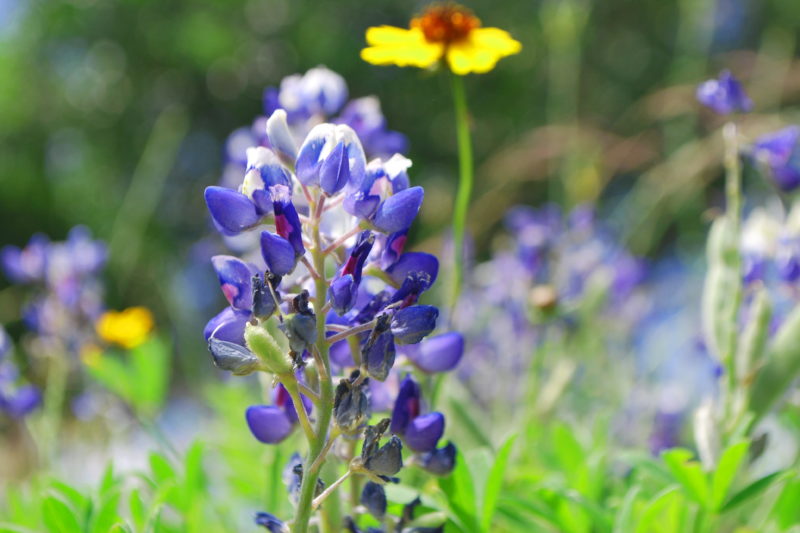Global Warming Is Changing the Way Bluebonnets Bloom
By Azriel Hebrado
Reporting Texas

Bluebonnets were out early this year, and more early blooms are expected because of global warming. Azriel Hebrado / Reporting Texas
The eyes of Texas fall on few springtime events with more pride than the emergence of swirling seas of bluebonnets. This year, the state flower’s abnormally early appearance has some observers pegging it as a harbinger of accelerating climate change.
An abundance of rain and unseasonably high temperatures ushered in one of the earliest spring since Texas officially started keeping records in 1880. Despite March 20 being the season’s official start, Central Texans began seeing bluebonnets in their backyards in early February.
The main driver in the bluebonnet’s early arrival is likely the unusually high temperatures posted in the early months of 2017. February was the warmest on record and March was projected to snap a record as well, says John Nielsen-Gammon, the state climatologist and a professor in the Atmospheric Sciences department at Texas A&M University, in an email.
“Temperatures were more than a month ahead of schedule,” he said.
“In terms of timing, January was warmer than the 20th century February average by 1.5 degrees Fahrenheit, and February was warmer than the 20th century March average by 2.2 degrees,” Nielsen-Gammon said, something he attributes to a long-term global-warming trend and unusually high temperatures in the Gulf of Mexico.
An early spring, as defined by Nielsen-Gammon, is a set of weather conditions that leads to early greening, growing and blooming of plants. In addition to direct evidence, scientists use satellite measurements of vegetation greenness and feed weather data into models that predict emergence and growth of plants.
“These factors together account for maybe 3 to 3.5 degrees of the unusual winter warmth, leaving 2.5 to 3 degrees for the randomness of the weather,” said Nielsen-Gammon.
For Central Texas, this means bluebonnets made their debut two to three weeks earlier than usual. “Fall rains resulted in good bluebonnet germination, and continued periodic moisture kept them healthy,” said Andrea DeLong-Amaya, the director of horticulture at the Lady Bird Johnson Wildflower Center at The University of Texas at Austin, in an email.
“We had a warm end of winter that nudged them to bloom early,” she said.
Central Texas isn’t the only region that has seen early wildflower blooms. East and South Texas have seen higher temperatures throughout the early months this year, said Nielsen-Gammon. The Gulf Coast will also be seeing above-average rainfall throughout the spring season.
What will maintain the show of bluebonnets, says DeLong-Amaya, is the continued above-average rainfall expected for the rest of this season, according to the National Weather Service. “If the showers shut down, so will the flowers,” she said.
While picturesque, an early spring brings hazards as well. One is the possibility of a late, hard frost that can damage even hardy wildflower stock. The timing of the wildflower bloom can also affect bees and other insects dependent on flowers.
“There has been documentation that many native plants are timed to bloom when their specific pollinators emerge from diapause, or an insect’s period of suspended development,” said DeLong-Amaya. “This ensures a food source for the pollinators, and the plant receives pollination services. If plants and pollinators are triggered by different conditions, they may not synchronize to the detriment of both species.”
The early and warm spring can also affect other plants. “Corn and sorghum farmers generally try to plant as early as possible to avoid heat and drought stress that is typical during the summer,” said Ronnie Schnell, assistant professor and state cropping systems specialist with the Soil and Crop Science Department at Texas A&M University, in an email.
“Warmer temperatures this year warmed soil temperatures and enabled some acres of corn and sorghum to be planted a bit sooner than normal,” Schnell said, although higher late-spring temperatures typically have a bigger bearing on these crops.
Whither the bluebonnet? Long-term warming trends aren’t going away anytime soon, says Nielsen-Gammon, with the odds favoring a new normal — higher spring and summer temperatures.
With average global temperatures increasing every year, there may be a chance to see bluebonnets in January or even December, DeLong-Amaya says. “It is certainly possible,” she said. “If we continue to get warmer earlier, it is possible we might see more flowering earlier in the season.”